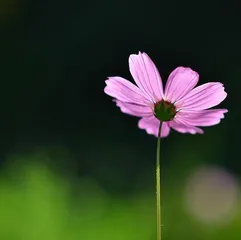Cosmos is a very beautiful flower, with rich colors and graceful posture, often used as an ornamental flower. However, many people do not know its flowering time and maintenance techniques. This article will introduce the flowering time and maintenance techniques of cosmos to help everyone better understand and maintain this beautiful flower.

I. Flowering Time of Cosmos
Cosmos generally blooms in spring and autumn each year, while it often stops blooming in summer. However, if proper pruning is done in spring, it can encourage continued blooming in summer and autumn, increasing its ornamental value.
II. Watering Tips for Cosmos
Cosmos has high water requirements, especially in summer and dry climates. Therefore, when caring for it, you should pay attention to watering in time to keep the soil moist. However, do not overwater to avoid waterlogging and rot.

III. Fertilizing Tips for Cosmos
Cosmos needs a lot of nutrient support during its growth period, so it should be fertilized regularly. Generally, fertilize once every two weeks or so to ensure it has sufficient nutrients.
IV. Sunlight Tips for Cosmos
Cosmos needs sufficient sunlight to grow well. Therefore, when choosing a planting location, you should choose a place with plenty of sunlight and ensure it gets enough sunlight every day.
V. Pruning Tips for Cosmos
The branches of cosmos can easily grow too long, so they need to be pruned regularly. Generally, pruning once in spring and autumn each year is sufficient to promote its growth and flowering.

VI. Pest and Disease Control Tips for Cosmos
Cosmos is relatively susceptible to pests such as aphids and spider mites, so attention should be paid to pest and disease control during maintenance. You can regularly spray insecticides and fungicides to prevent the occurrence of pests and diseases.
VII. Planting Methods for Cosmos
The planting method of cosmos is relatively simple and can be done by sowing or transplanting. When planting, you should choose a place with sufficient sunlight and good drainage, and pay attention to the distance with other plants.
VIII. Flower Language and Meaning of Cosmos
Cosmos is a flower full of cultural connotations and artistic value, and its flower language and meaning are also very rich. Cosmos is often seen as a symbol of love for freedom and equality, with the meaning of beauty, grace, and freedom.
IX. Variety Classification of Cosmos
There are many varieties of cosmos, including large cosmos, small cosmos, purple cosmos, white cosmos, and so on. Each variety has its own unique characteristics and advantages, and you can choose according to your own preferences.
X. Matching and Pairing of Cosmos
Cosmos is a flower that is very suitable for matching and pairing. It can be combined with other plants and flowers to create different beautiful landscapes. When pairing, pay attention to the matching of colors and shapes to achieve the best results.
XI. Uses of Cosmos
In addition to being used as an ornamental flower, cosmos has many other uses, such as for making bouquets, decorating rooms, and making medicines. Therefore, when planting cosmos, its uses also need to be considered.
XII. Harvest Time for Cosmos
Cosmos generally starts to bloom 2-3 months after planting, and its harvest time is usually about 1-2 weeks after flowering. When harvesting, pay attention to avoiding sun exposure and wind to avoid affecting its quality and appearance.
XIII. Storage Methods for Cosmos
The storage method for cosmos is relatively simple. You can place it in a dry, ventilated, and cool place, and try to avoid direct sunlight and excessive moisture. When storing, you should also pay attention to placing them separately to avoid bacterial contamination.
XIV. Market Prospects for Cosmos
With the increasing pursuit of beautiful flowers and the continuous improvement of living standards, the market prospects for cosmos are becoming broader. As a high-quality ornamental flower, it will become an important variety in the flower market in the future.
Conclusion: Cosmos is a very beautiful flower, and its flowering time and care techniques are also very important. Through the introduction in this article, I believe that everyone has a better understanding of the flowering time and care techniques of cosmos. If you also like cosmos, you might as well try planting it.